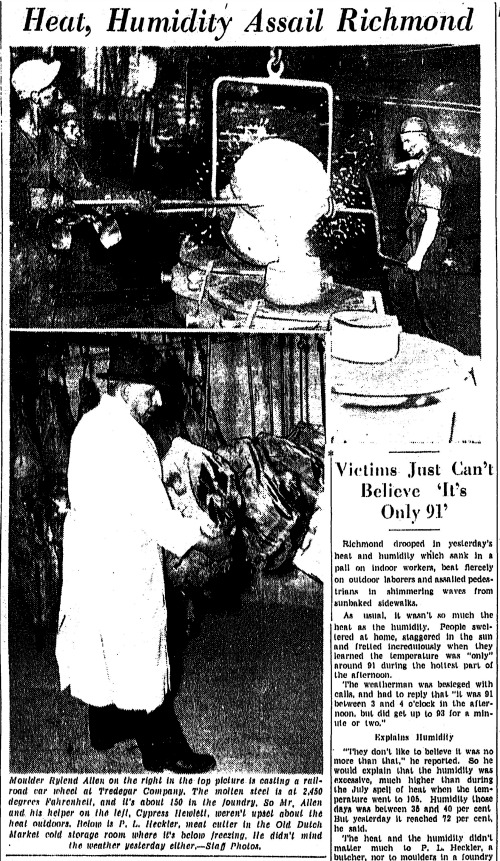From the Richmond Times-Dispatch, 8/22/1936, p. 1, c. 4

…Less than a mile from Mr. Heckler’s air-conditioned “office,” soot-smeared, sweating men case railroad car wheels at Tredegar Company’s iron foundry in a huge, blackened building where the temperature gets up to 150 degrees.
The moulders and their Negro helpers rushed through the work of casting in the high building floored with black sand, filled with rows of smoking iron wheel moulds, and every minute or so lit by a wide spray of enormous gold sparks as a stream of molten steel poured from a “pouring ladle” on a pulley overhead into a waiting mould below.
At the end of the building a great cauldron glowed from the oven behind it, and sometimes tipped to pour out a thick stream of the red, syrupy steel, to feed the ladle buckets riding back and forth on the pulleys. The big pot is the “teapot” ladle and provides indoor weather that makes outdoors feel like May in the mountains.
Moulders Rush Around
It was hot there, they didn’t know just how hot. They don’t use a thermometer. But one got an idea when a redhot, new-cast wheel rode swinging past on a pulley, brushing the face with a blast of heat; or when one stood a few feet away from a glowing stream of steel pouring into a mould. It’s too hot to go without a shirt, anyway, the moulders find.
Mr. Heckler’s working pace in his ice box is slow-motion compared to the speed of the Tredegar moulders as they pour steel, remove new wheels, and send them swinging down the pulley to cool. He steps lively to keep warm, and they rush like mad to handle the metal while it’s hot enough.
“You get used to is,” grinned the moulders at the mention of their foundry heat. The temperature of 150 – their guess – is short-lived, and the entire period of intense heat is about three hours.
But it’s just pleasant compared to the sun outside, according to Moulder Robert C. Southall.
“Sun heat outdoors is a lot worse to me,” he said. Which seems to be because a foundry is not troubled with humidity.
- Details
- Categories:: Richmond Times-Dispatch Post-War Newspapers After 1865 Tredegar Iron Works Weather
- Published: 15 October 2017

